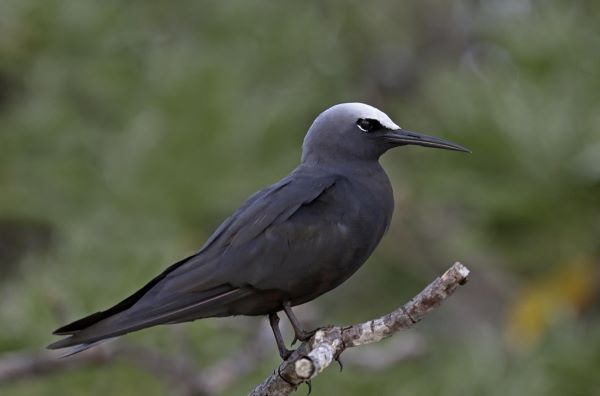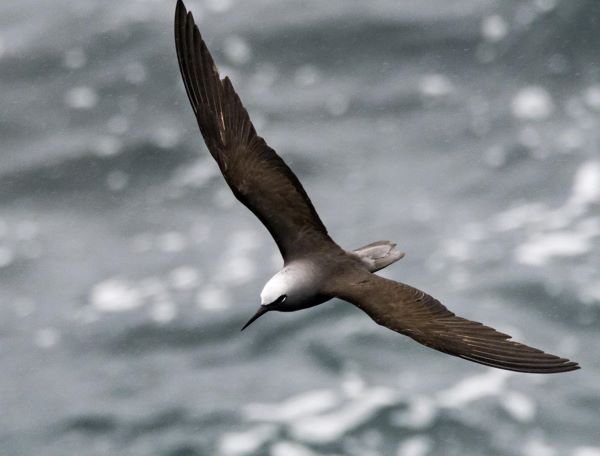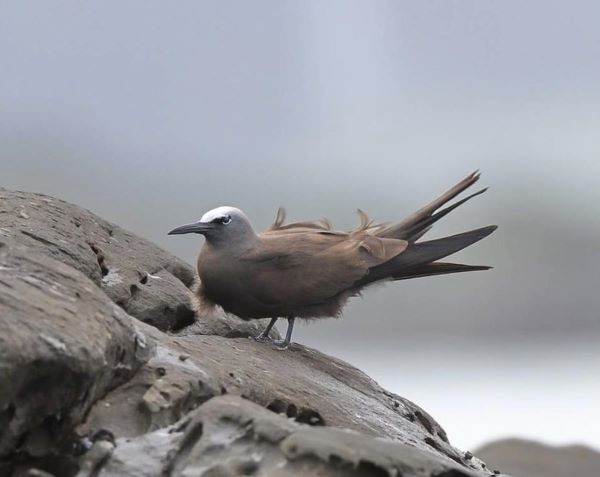Family: The black noddy (Anous minutus) is a species of tern in the family Laridae in the order Charadriiformes.
Behavior: The black noddy does not migrate or wander much. During the non-breeding season, they commonly return to roost on their nesting islands. Individual birds seem to be either involved in breeding or molt almost all the time; some even nest while still in molt. This is unusual because molting and breeding each cost so much energy that birds, as a rule, undergo them separately. Because both sexes continuously dip their heads during their breeding display, it is possible that they earned the nickname “noddies” because of their behavior.
These medium-sized sea birds leave the roosting and nesting grounds for the open sea to fish in the early morning and return just before dark. During the day, flying young also depart from their nesting islands, but they return in the late afternoon or early evening to get food from their parents. Their calls at feeding time can be heard from about two kilometers out to sea.
When roosting, the Black Noddy adopts a sunbathing posture, with its tail and one wing spread and its head to one side. It is a tame bird and can be picked up from the nest. At sea, it is typically observed within 70–80 km of its breeding colonies. During the night, the birds return to sleep on nearby islands or their colonies.
Vocalizations: Black Noddy has three distinct calls; the staccato alarm note is the loudest and most distinctive. Others are kerr; and a cackling, krikrikrik at roosting sites. It preens frequently, probably, like other seabirds, to remove parasites.
Diet: They snatch up their food—mainly small fish, but also cuttlefish, other mollusks, jellyfish, and plankton—from the surface of the water with their bills. In this, they are like other noddies, but they work the inshore surf around islands and headlands much more, nipping in and out, under and along curling breakers, with unequaled agility. Plunge-diving for food is rare, but it does happen.
Identification: Both adult sexes are similar. The body plumage, tail, and wings are sooty black. Forehead and crown silver-white, shading abruptly to grey on the back of the neck. A thin white arc runs above and below to divide the black lores as they continue to the edge of the eyes. The tail is forked, and the eyes are brown. The bill is black, and the legs are dark brown. Identified from other noddies by blackish plumage with jet-black lores, intermediate size, longer and more slender bill, and distinctly forked tail. The immature bird is similar to adults. The downy young are grey-white.
Nesting and Breeding: Black noddy nesting and breeding occur mainly in August–January in Australia, in closely packed colonies. Nestle a shallow cup of soft leaves interwoven with seaweed, grass, and tree roots, cemented with excreta and sticky vegetable matter, about 150 mm in diameter. Usually, the nest is placed 1–10 meters above ground in forks of tree branches. To the point where they can be removed from the nest, they exhibit remarkable tolerance towards humans.
Eggs and Incubation: The bird lays one egg, coarse, matt cream, thinly blotched with rufous and purple-grey, particularly at the larger end; rounded oval, 46 x 33 mm. The incubation period is about 33–35 days for both sexes. The young wandered from the nest and returned in the evening, where they were fed by their parents.
Distribution: Black noddy is found on the northeastern coast, islands, and coral cays from Darnley Island, Torres Strait, south as far as Capricorn Group, Queensland; vagrant south to the region of Sydney, New South Wales. It also breeds in the tropical Pacific, Indian, and Atlantic Oceans, including Norfolk Island.
Other Names: It is also known as White-capped Noddy and Titerack.
Size: Black Noddy measures about 350–360 mm in length, including a 120 mm tail, with a tapered wingspan of 645–650 mm and weighs 100–144 grams
Status: The population is stable; hence, it is the least concerned on the IUCN list.
Races: There are about seven races: one in the Australian region and another on Christmas Island.
-
minutus Boie, found northeast Australia and New Guinea to Tuamotu Archipelago
-
worcesteri found in Cavilli Island and Tubbataha Reef (Sulu Sea)
-
atlanticus found in tropical islands in the Atlantic
-
marcusi found in Marcus and Wake Islands through Micronesia to the Caroline Islands
-
americanus found in islands in the Caribbean Sea
-
melanogenys found in the Hawaiian Islands to the Kermadec Islands
-
m. diamesus found in Clipperton Island (off western Mexico) and Cocos Island (off western Costa Rica)
Read More: 10 American Birds of Prey
-

The black noddy (Anous minutus) is a species of tern in the family Laridae in the order Charadriiformes. Photo Credit: patrickkavanagh 
It is also known as White-capped Noddy and Titerack. Photo Credit: Byron Chin 
The black noddy does not migrate or wander much. During the non-breeding season, they commonly return to roost on their nesting islands. Photo Credit: Hiyashi Haka






